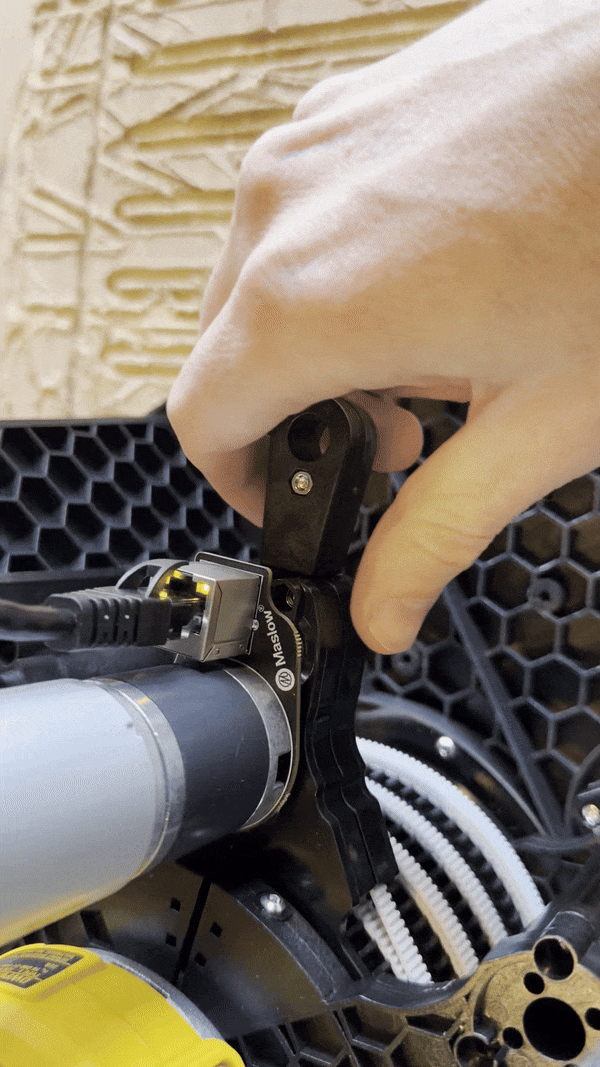I need some help! I did the flash firmware dance with the button…
Took it out to the garage and got it to retract.
Then extended and anchored.
I never could get it to log onto my network or to see it on the network.
BTW, the network setup page -really- need some “english” applied to it. SUPER hard to tell what is what… Could we maybe describe things as the “Maslow server”???
Initial calibration seemed to work, then the second round pulled out the upper left belt and I hit stop. After that I couldn’t get anything to work.
I’ve re-flashed at least 5 times time and I think, maybe, its working? I’m getting this memory low error and the internet connection keeps dropping off (direct maslow server).
Too much sweating and swearing in the garage, gotta take a break…
Serial Messages
Index.html Version: 1.07
[MSG:INFO: FluidNC v3.0.x (noGit)]
[MSG:INFO: Compiled with ESP32 SDK:v4.4.7-dirty]
[MSG:INFO: Local filesystem type is littlefs]
[MSG:INFO: Configuration file:maslow.yaml]
[MSG:INFO: Machine Maslow S3 Board]
[MSG:INFO: Board Maslow]
[MSG:INFO: UART1 Tx:gpio.1 Rx:gpio.2 RTS:NO_PIN Baud:115200]
[MSG:INFO: SPI SCK:gpio.12 MOSI:gpio.11 MISO:gpio.13]
[MSG:INFO: SD Card cs_pin:gpio.10 detect:NO_PIN freq:8000000]
[MSG:INFO: Stepping:Timed Pulse:4us Dsbl Delay:0us Dir Delay:0us Idle Delay:240ms]
[MSG:INFO: Axis count 3]
[MSG:INFO: Axis X (-2438.400,0.000)]
[MSG:INFO: Motor0]
[MSG:INFO: Axis Y (-1219.200,0.000)]
[MSG:INFO: Motor0]
[MSG:INFO: Axis Z (-100.000,0.000)]
[MSG:INFO: Motor0]
[MSG:INFO: tmc_2209 UART1 Addr:0 Step:gpio.15 Dir:gpio.16 Disable:NO_PIN R:0.110]
[MSG:INFO: Motor1]
[MSG:INFO: tmc_2209 UART1 Addr:1 Step:gpio.46 Dir:gpio.38 Disable:NO_PIN R:0.110]
[MSG:INFO: Z Axis driver test passed]
[MSG:INFO: Z2 Axis driver test passed]
[MSG:INFO: Kinematic system: Cartesian]
[MSG:INFO: Using spindle NoSpindle]
[MSG:INFO: STA SSID is not set]
[MSG:INFO: AP SSID maslow IP 192.168.0.1 mask 255.255.255.0 channel 1]
[MSG:INFO: AP started]
[MSG:INFO: WiFi on]
[MSG:INFO: Captive Portal Started]
[MSG:INFO: HTTP started on port 80]
[MSG:INFO: Telnet started on port 23]
[MSG:INFO: Channel auto report interval set to 50 ms]
Retract All
[MSG:INFO: Retracting all belts]
[MSG:INFO: Requesting state change from Unknown to Retracting Belts]
[MSG:INFO: Succeeded]
[MSG:INFO: Bottom Right pulled tight with offset -0.011]
[MSG:INFO: Top Left pulled tight with offset 0.000]
[MSG:INFO: Top Right pulled tight with offset 0.000]
[MSG:INFO: Bottom Left pulled tight with offset 0.000]
[MSG:INFO: Requesting state change from Retracting Belts to Belts Retracted]
[MSG:INFO: Succeeded]
Stop
Release Tension
[MSG:INFO: Requesting state change from Belts Retracted to Releasing Tension]
[MSG:INFO: Cannot release tension from state Belts Retracted]
Retract All
[MSG:INFO: Retracting all belts]
[MSG:INFO: Requesting state change from Belts Retracted to Retracting Belts]
[MSG:INFO: Succeeded]
[MSG:INFO: Top Left pulled tight with offset 0.000]
[MSG:INFO: Top Right pulled tight with offset 0.000]
[MSG:INFO: Bottom Right pulled tight with offset 0.000]
[MSG:INFO: Bottom Left pulled tight with offset 0.000]
[MSG:INFO: Requesting state change from Retracting Belts to Belts Retracted]
[MSG:INFO: Succeeded]
Stop Maslow and Gcode
[MSG:INFO: Caution: Unlocked]
Retract All
[MSG:INFO: Retracting all belts]
[MSG:INFO: Requesting state change from Belts Retracted to Retracting Belts]
[MSG:INFO: Succeeded]
[MSG:INFO: Bottom Right pulled tight with offset 0.011]
[MSG:INFO: Top Right pulled tight with offset 0.000]
[MSG:INFO: Top Left pulled tight with offset 0.000]
[MSG:INFO: Bottom Left pulled tight with offset 0.000]
[MSG:INFO: Requesting state change from Retracting Belts to Belts Retracted]
[MSG:INFO: Succeeded]
Stop
Retract All
[MSG:INFO: Retracting all belts]
[MSG:INFO: Requesting state change from Belts Retracted to Retracting Belts]
[MSG:INFO: Succeeded]
[MSG:INFO: Top Right pulled tight with offset 0.000]
[MSG:INFO: Bottom Left pulled tight with offset -0.011]
[MSG:INFO: Bottom Right pulled tight with offset -0.011]
[MSG:WARN: Low memory: 13884 bytes]
[MSG:WARN: Low memory: 10724 bytes]



